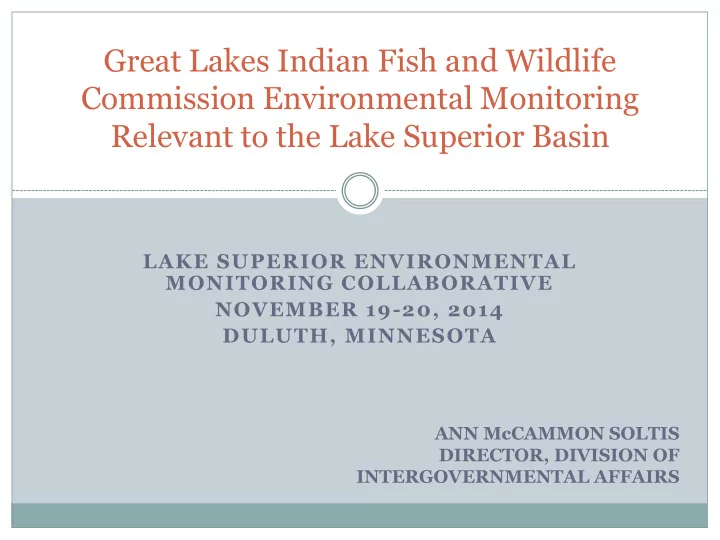

Great Lakes Indian Fish and Wildlife Commission Environmental Monitoring Relevant to the Lake Superior Basin LAKE SUPERIOR ENVIRONMENTAL MONITORING COLLABORATIVE NOVEMBER 19-20, 2014 DULUTH, MINNESOTA ANN McCAMMON SOLTIS DIRECTOR, DIVISION OF INTERGOVERNMENTAL AFFAIRS
Treaty Rights Reserved by Member Tribes Treaties signed with the US in 1836, 1837, 1842 and 1854. Tribes reserved the rights to hunt, fish and gather within the territory ceded. Purpose: to maintain a “lifeway” to meet Subsistence, Economic, Cultural, Spiritual and Medicinal needs. Federal courts, including the US Supreme Court, have reaffirmed these rights.
GLIFWC’s Mission and Role Intertribal Natural Resource Agency Formed in 1984 to assist its 11 member tribes in the implementation of their off-reservation treaty reserved rights. Tribes have a stake in natural resource management Impacts the quantity and quality of the natural resources to which they have a treaty right. Part of GLIFWC’s mission is to “protect ecosystems in recognition that fish, wildlife and wild plants cannot long survive in abundance in an environment that has been degraded.” GLIFWC has been a participant in the Binational Program to Restore and Protect Lake Superior since 1993.
GLIFWC Environmental Monitoring GLIFWC’s monitoring work is broad-based: Population monitoring of natural resources like deer, walleye, lake trout Monitoring and restoration of endangered pine marten (WI) Invasive species monitoring and control Wild rice monitoring and reseeding Water quality monitoring in areas where mineral development may be proposed Mercury monitoring in fish
GLIFWC Environmental Monitoring (cont.) GLIFWC’s Environmental Monitoring includes some less “western” notions of monitoring Traditional Ecological Knowledge (TEK) can provide baseline data about an ecosystem or resources; tribes have had relationships with these resources and places for hundreds of years. GLIFWC recently convened a “talking circle” of hunters to discuss deer management through storytelling. Harvest monitoring is another important way to monitor, especially when you consider that for GLIFWC’s tribes, the very act of harvest is an act of management and stewardship.
GLIFWC Environmental Monitoring - Mercury GLIFWC tests mercury content in fish for several reasons: To inform tribal members so that they can choose what fish to consume from which lakes To maintain long term data for trend analysis To advance the goals of the LAMP and the GLWQA that seek a Lake Superior basin in which fish are safe to eat GLIFWC coordinates sampling and shares its data with the Wisconsin DNR, and it is maintained in a joint database that is used to produce fish consumption advisories. GLIFWC also provides data to the Michigan DEQ and the Minnesota Department of Public Health. Sampling has expanded into Lake Superior, including sturgeon, walleye, lake trout and whitefish.
Fish Advisory Maps (Front) Sensitive Population Color-coded Meal Frequency Advice Less Sensitive Population
GLIFWC Environmental Monitoring - Mining Monitoring in watersheds potentially impacted by mineral development Identified as a LaMP priority for the 2011 CSMI Intensive Monitoring Year Worked in coordination with USGS, and 4 tribes in the Lake Superior basin to sample sediment, water quality and water quantity (stream flow). GLIFWC has maintained its water quality sampling since 2011 through other funding sources. GLIFWC is working with USGS to explore ways to integrate stream flow and water quality data to make it more widely available Water quality parameters include: 27 lab parameters including trace metals, metaloids, and anions 8 field parameters including specific conductance, temperature, and pH
Watersheds sampled as part of GLIFWC's baseline monitoring program
GLIFWC Environmental Monitoring – Invasive Species GLIFWC does a variety of invasive species monitoring, most relevant here are: Sea lamprey assessments in coordination with the Great Lakes Fisheries Commission and the US Fish and Wildlife Service. Interagency efforts to eradicate invasive phragmites before it becomes established in the basin. Purple loosestrife monitoring and control in the nearshore and elsewhere using biological controls (i.e. Galerucella beetles) GLIFWC also compiles and makes available through an interactive web mapping tool, data from a federal, state and local agencies that monitor aquatic invasive species. Invasive species is a Binational Program focus Including development of the AIS Complete Prevention Plan.
GLIFWC Environmental Monitoring – Important Habitats The LAMP 2000 identified stamp sands as a principal stressor to Lake Superior’s aquatic habitat. In 2005, GLIFWC undertook a project, in coordination with other governmental agencies, to map an important lake trout and whitefish spawning reef, describe the substrate, and document the extent of stamp sands that were moving toward the reef. A multi-jurisdictional efforts is underway to keep the sands from encroaching further onto the reef.
GLIFWC Environmental Monitoring – Climate Change 2 climate change projects in the planning stages A phenology study at two sites (one within the basin, one yet to be selected) will provide current information about plant life cycles and the influence of variations in climatic conditions. Six plant species of importance to tribes will be studied, including sugar maple. Continuous weather data will be also collected. A temperature/depth study of lake trout Repeat of a study conducted from 2001-04. Fish are implanted with archival tags. Tags recovered will be analyzed and compared with earlier results that show at what temperature and depth these fish are spending their time.
GLIFWC Monitoring Supports LAMP Goals In discussions with the Superior Workgroup and as part of the CSMI process, several issues have emerged that may warrant additional monitoring: Additional baseline data collection related to potential mineral development – macroinvertebrate and/or temperature monitoring (also advances climate change questions) Effects of mercury emissions from the mining sector if new mines being proposed are permitted Oil transportation in the Lake Superior basin via pipeline and rail, particularly Bakken crude
Recommend
More recommend